Gone are the days when people believed the earth was flat and supported by elephants. In ancient times, many scientists and astronomers argued that the earth is spherical and revolves around its axis. Nowadays, this is common knowledge from childhood. But why is our planet still round? To answer this question, we need to take into account several important facts.
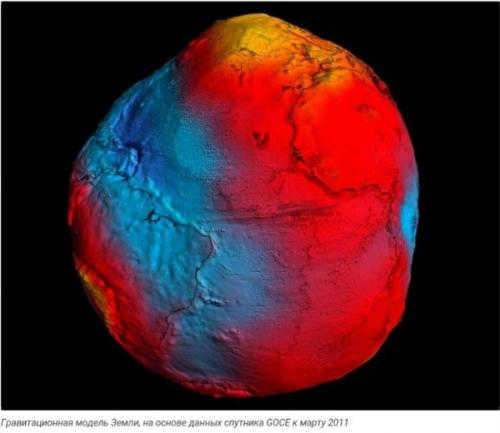
The shape of the Earth is determined by the composition of the planet and its gravitational force.
Similar to other celestial bodies with significant mass, the Earth is spherical due to the influence of gravity, which governs the movement of almost all objects in space. The strength of gravity is directly proportional to the mass of the celestial body.
Large celestial bodies in close proximity to Earth, such as the moon and the sun, possess immense mass, resulting in a stronger gravitational force. This force acts upon the Earth’s surface, causing it to take on the spherical shape that we observe. Additionally, this gravitational force ensures that each point on the Earth’s surface is equidistant from its center.
Equally important is the existence of one of the elements that compose planet Earth. This particular element is known as scorching magma, which lies beneath the crust and periodically emerges on the Earth’s surface in the form of active volcano eruptions. Without it, the force of gravity would not have such a profound impact on the formation of our planet – in order for this celestial body to be adequately malleable, it must be either gaseous or liquid.
However, we can make a slight amendment by stating that referring to the Earth as perfectly round would not be entirely accurate either. And there is substantial evidence to support this statement.
Confirmation of the widely accepted shape of our planet.
The earth has a polar radius of 6357 kilometers and an equatorial radius of 6378 kilometers, resulting in a difference of 19 kilometers. This means that it is not quite accurate to call the planet a perfect sphere, as it is slightly flattened at the poles and stretched along the equator. This shape is influenced by the earth’s rotation and the centrifugal force it generates.
The strength of the centrifugal force, which counteracts the force of gravity, increases as you move away from the poles. Additionally, due to the earth’s rapid rotation, the speed of any point on the equator can be compared to that of a supersonic airplane.
It is not possible for the Earth to be perfectly round due to the presence of hot magma, which is a liquid, only beneath the Earth’s crust. The crust itself is a solid substance. Please note that the Earth’s surface would need to be entirely liquid in order for it to have the exact shape of a sphere.
However, it is important to mention that the liquid on the Earth’s surface is also influenced by various phenomena, specifically the gravitational force of other celestial objects. For instance, the moon’s gravitational force can cause tides, slightly distorting the shape of the Earth’s liquid shell. Source: sciencedebate2008. com.
What is the reason behind the spherical shape of our planet?
The roundness of the Earth has been a subject of curiosity for many researchers in the present era. It is widely acknowledged that the Earth is not flat and it does not rest on the back of a gigantic turtle. Nonetheless, despite the presence of an answer, there exist disagreements among the scientific community. Let us unravel the enigma and shed light on the reasons behind the Earth’s spherical form. We will elucidate it for you!
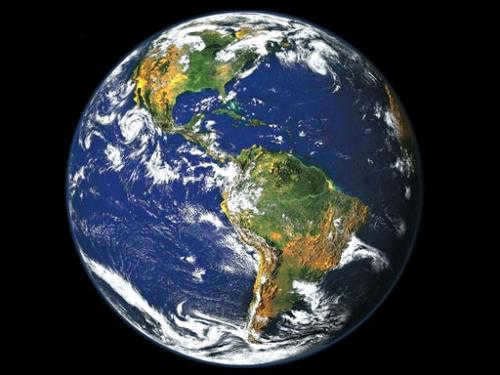
All celestial bodies, including planets, stars, and satellites, share a common characteristic – they are round. This round shape is primarily due to the force of gravity. Gravity exists in every object and has the ability to attract other objects and even its own components. The strength of gravity is directly related to the size of the object. In the case of our planet, it is so massive that it exerts a strong gravitational pull towards its center. This is why we experience the sensation of falling when we bounce in place or jump – we are being pulled towards the Earth’s center by its gravity. This same gravitational force is responsible for shaping liquid bodies, such as the oceans and seas, which contour the Earth’s surface.
Scientific evidence confirms that gravity exists in all types of matter. It is this force that shapes the physical structure of an object, transforming it into a spherical form. If we were to release a drop of water into space, it would naturally take on a spherical shape, resembling a balloon. Liquids have the ability to form into spherical shapes due to the absence of strong molecular bonding. On the other hand, solids, like asteroids, lack this capability because their molecules are tightly bonded, preventing them from assuming a spherical shape. This is why solid objects often appear shapeless, unlike their liquid counterparts.
We should also acknowledge that the Earth is not a perfect sphere. It contains both mountains and valleys. What is the reason for this?
The Earth has a slightly flattened shape, with a difference of nineteen kilometers between its radii. This is because the Earth rotates on its axis. When we drive a car and make a turn, our body is pulled towards the outside of the turn due to centrifugal force. It is important to note that the speed of our planet is extremely high, although it is not visible to us. The theory of relativity further explains that the Earth is not a perfect sphere, but rather flattened.
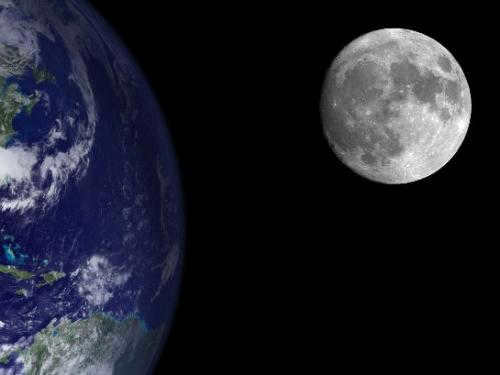
In the hypothetical scenario where the Earth’s entire surface was composed solely of water, its shape would be perfectly spherical. However, we are aware that the presence of mountains and depressions on the Earth’s surface is not a random occurrence. These features are influenced by the gravitational force exerted by the Moon. Due to its large size and proximity to the Earth, the Moon has the ability to alter the shape of our planet. This gravitational influence affects the subterranean crust, leading to the formation of mountains and depressions. However, these changes occur over long periods of time and are not immediately noticeable.
If you come across any errors, please highlight the corresponding text and press Shift + E or let us know in order to inform us!
Reasons behind the Earth’s Spherical Shape and the Variation of Constellations across Different Locations
What is the explanation for the Earth’s roundness? This is the very question that led Aristotle to question the notion of a flat planet. Throughout his journeys in Africa and Europe, he meticulously recorded the celestial transformations he observed. As his collection of sketches grew, he began to notice a divergence in the images of the night sky.

Although there is a legend that it was not Aristotle but his servant who was working on the ship, mapping the sky during his scientific duty. This may or may not be true, but it is not particularly important now. What is more important is that this discovery was made.
Another piece of evidence was the finding that all objects with significant mass fall to the Earth at the same angles. These simple observations lead to the conclusion that the Earth is spherical in shape. In scientific terms, the shape of the Earth is referred to as a geoid. However, this does not encompass the essential understanding of the Earth for the average person, which involves complex astronomical calculations.
What is gravity and how does it work?
Gravity, also known as the force of gravitation, is the natural phenomenon that causes two objects to be attracted to each other. It is responsible for the falling of apples to the ground and the rotation of planets around the sun. The strength of gravity is determined by the mass of the objects involved, with more massive objects exerting a stronger gravitational pull.
A fundamental force in nature
Gravity is considered one of the fundamental forces in the universe, alongside electromagnetism, strong nuclear force, and weak nuclear force. These forces govern the behavior of matter and energy at the most fundamental level.
One of the notable effects of gravity is weight. When you step on a scale, it measures the force of gravity acting on your body. On Earth, the acceleration due to gravity is approximately 9.8 meters per second squared, or 9.8 m/s^2.
According to ancient philosophers like Aristotle, it was believed that heavier objects would fall faster towards the ground. However, subsequent experiments have revealed that this notion is false. The difference in the rate at which a feather and a bowling ball fall is actually due to air resistance, which opposes the force of gravity.
Newton’s law of universal gravitation states that the force of gravity is directly proportional to the product of the masses of two objects and inversely proportional to the square of the distance between them.
In the 1680s, Isaac Newton developed his theory of universal gravitation. He discovered that gravity affects all matter and is determined by both mass and distance. Each object exerts a force on another object that is directly proportional to the product of their masses and inversely proportional to the square of the distance between them.
The Concept of Relativity
In the year 1687, Newton presented his findings on the phenomenon of gravity, which were widely regarded as the most accurate explanation at the time. However, in 1915, Einstein introduced his groundbreaking General Theory of Relativity, which revolutionized our understanding of gravity. According to Einstein’s theory, gravity is not a force in the traditional sense, but rather a result of the distortion of space-time caused by matter. One of the notable predictions of the General Theory of Relativity is the phenomenon of light bending around massive objects.
Interesting Facts
- The Moon has approximately 16 percent of the gravity of Earth, Mars has around 38 percent of Earth’s gravity, and the largest planet in the solar system, Jupiter, has 2.5 times the gravity of Earth.
- While the concept of gravity was not “discovered,” it is said that the renowned astronomer Galileo Galilei conducted some of the earliest gravity experiments by dropping balls from the Leaning Tower of Pisa to observe their rate of descent.
- Isaac Newton, who was just 23 years old and had recently returned from university, observed an apple falling in his garden and embarked on unraveling the mysteries of gravity. (It is uncertain whether the apple actually hit his head, as the popular myth suggests).
- One early confirmation of Einstein’s theory of relativity was the bending of starlight near the Sun during a solar eclipse on May 29, 1919.
- Black holes are incredibly large entities that possess such immense gravitational force that not even light can break free from their clutches.
- Einstein’s general theory of relativity and quantum mechanics, the peculiar set of principles that dictate the actions of infinitesimal particles such as photons and electrons, are fundamentally incompatible.
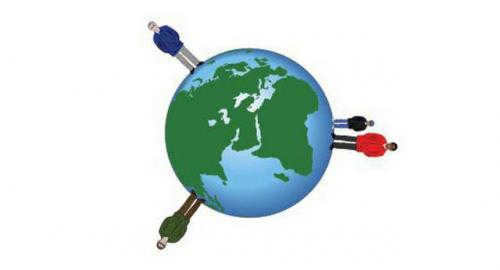
When pondering the enigma of why individuals do not plummet from the Earth’s surface, it is quite effortless to conceive of a multitude of comparable riddles. For instance, why does a discarded cookie invariably descend to the floor rather than launching into flight? Alternatively, why is it unfeasible for a person to embark upon a stroll along a park pathway and momentarily soar above it? Furthermore, how is it feasible for individuals to traverse the opposite side of the planet? Indeed, what is the clandestine force that prevents us from being flung off the Earth, an orb that perpetually rotates, due to centrifugal force? The solution to all of these queries can be succinctly addressed with a solitary term – “gravity”.
What is the mechanism behind the force of gravity?
Why don’t people and objects fall off the surface of the Earth? Gravity, also known as universal gravitation, is a fundamental force that causes bodies with mass to be attracted to each other. While the weight of people and objects on Earth is relatively small compared to the vastness of the cosmos, the force of gravity is still present and keeps everything grounded. The interaction between stars and planets is more noticeable due to their larger masses. In fact, the gravitational pull of the Sun is responsible for the planets’ circular and elliptical orbits within our solar system. Scientists also believe that the gravitational compression of a massive gas-dust cloud played a role in the formation of our planetary system around this star.
The Earth’s immense gravitational pull, which weighs nearly 6 sextillion tons (5.976), is the reason why people can walk on its surface without fear of floating off into space. Gravity also holds a vital atmosphere around the Earth, allowing for life to thrive. This force prevents oceans, seas, and rivers from overflowing and keeps the planet intact, preventing it from disintegrating into cosmic particles. Additionally, the mutual attraction between the Earth and the Moon ensures that our satellite remains in a stable orbit.
The law of universal gravitation can be expressed through the following formula:
How was the discovery and proof of universal gravitation accomplished?
An individual possesses curiosity, and their interest was piqued by the question of why individuals do not fall off the Earth’s surface.
- Throughout history, individuals have dropped a variety of objects on the ground. For some, it was merely an unfortunate occurrence. However, for curious minds like the renowned ancient scientists Plato and Aristotle, this phenomenon served as a catalyst for contemplation.
- Gravity garnered even more attention from Galileo, who observed the speed and trajectory of different objects falling from the inclined Tower of Pisa. He was astonished to discover that objects of various sizes, weights, and masses fell at the same rate of acceleration.
- Johannes Kepler uncovered the laws governing the motion of planets within our solar system.
- Isaac Newton’s work laid the foundation. He achieved the consolidation of previously gathered information into a unified whole, the formation of a coherent theory. Additionally, he presented a clear articulation of the law of universal gravitation. His renowned observations of falling ripe apples provided him with a solution to the problem.
Now, let us delve into the logical certainty behind the question of why people don’t fall off the Earth’s surface. The answer lies in one word: gravity (attraction, gravitation). It prevents all objects on Earth from soaring into space.
As one moves further away from the Earth’s surface, gravity diminishes. This allows spacecraft to overcome it and journey through space. This opens up opportunities for both ground-based and space-based examinations of Earth’s gravity and celestial bodies.
Gravity: Understanding the Fundamental Concept
Gravity, a fundamental force of nature, is a concept familiar to everyone since their school days. The famous tale of Newton’s apple hitting his head and leading to the discovery of the law of universal gravitation has been etched in our memories. However, the true nature of gravity is far from being simple. In this article, we aim to provide a lucid and comprehensive explanation of what gravity truly is. Additionally, we will address common myths and misconceptions surrounding this fascinating phenomenon.
Put simply, gravity is the force of attraction between any two objects in the universe. The strength of gravity can be calculated by considering the mass of the objects and the distance between them. The greater the gravitational field, the heavier an object will feel and the faster it will accelerate. For instance, an astronaut on the Moon would weigh six times less than they do on Earth. The strength of gravity depends on the size of the object it surrounds. Consequently, the gravitational force on the Moon is six times weaker than that on Earth. Isaac Newton was the first to scientifically explain and prove this concept through mathematical calculations in the 17th century.
What Causes the Rotation of the Earth?
“And still it turns!” – these are the famous words famously attributed to Galileo. Our planet not only revolves around the sun, but also rotates on its axis. The reasons behind this phenomenon have been the subject of various hypotheses, but scientists have yet to reach a consensus.
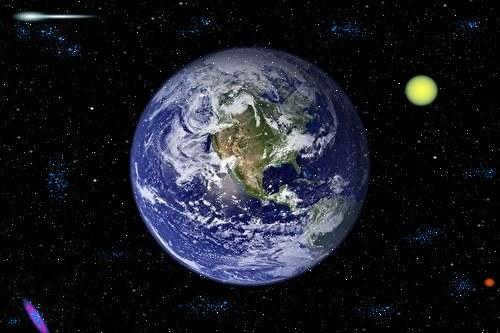
What causes the Earth to spin around its axis. The Earth’s rotation on its axis
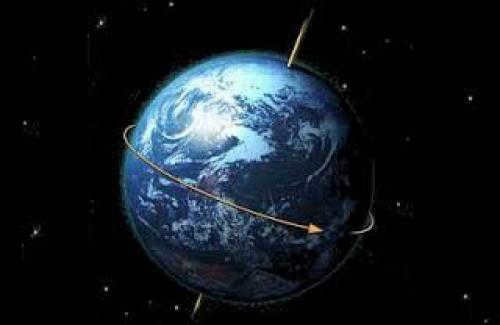
The Earth is in a perpetual state of motion, constantly rotating around the Sun as well as on its own axis. The axis of the Earth is an imaginary line that extends from the North Pole to the South Pole, remaining stationary while the Earth rotates. This axis is tilted at an angle of 66033ꞌ to the Earth’s plane. Despite this constant rotation, humans do not perceive the movement because all objects on Earth are moving parallel to each other at the same speed. It is similar to being on a ship and not being able to detect the movement of objects on board.
A full rotation around its axis takes place in one stellar day, which lasts for 23 hours, 56 minutes, and 4 seconds. Within this time period, different parts of the planet face the Sun, receiving varying amounts of warmth and light. Furthermore, the Earth’s rotation affects its shape, causing the poles to flatten due to this rotational movement. Additionally, this rotation also influences the horizontal movement of bodies such as rivers, currents, and winds. In the Southern Hemisphere, these bodies are deflected to the left, while in the Northern Hemisphere, they are deflected to the right.
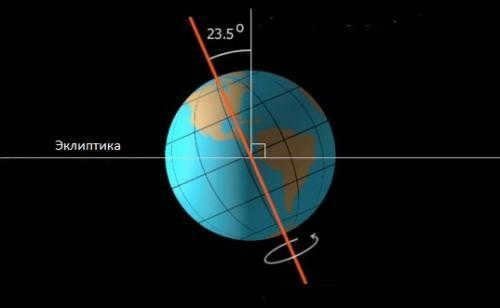
The Earth rotates around its axis at a linear speed of 465 m/s or 1674 km/h at the equator. However, as one moves away from the equator, the speed gradually decreases. At the North and South Poles, the speed of rotation becomes zero. For instance, in the equatorial city of Quito, the capital of Ecuador in South America, the rotation speed is 465 m/s. On the other hand, for Muscovites residing on the 55th parallel north of the equator, the speed of rotation is 260 m/s, which is almost half of the equatorial speed.
Every year, the velocity of rotation around the axis decreases by 4 milliseconds, as a result of the Moon’s impact on the intensity of sea and ocean tides. The gravitational force of the Moon attracts water in the opposite direction of the Earth’s axial rotation, generating a small amount of frictional force that decelerates the rate of rotation by 4 milliseconds. The angular velocity remains constant throughout, with a value of 15 degrees per hour.
What causes the transition from day to night?
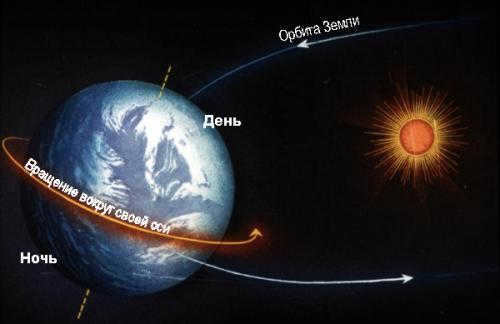

The Earth completes a full rotation around its axis in a period of time known as a sidereal day, which lasts 23 hours, 56 minutes, and 4 seconds. During this time, one side of the Earth is illuminated by the Sun, experiencing daytime, while the other side is in shadow, experiencing nighttime. This cycle then reverses.
If the Earth rotated differently and had one side constantly facing the Sun, extreme temperatures would prevail. The side facing the Sun would experience scorching heat, with temperatures reaching up to 100 degrees Celsius, causing all water to evaporate. On the other side, freezing temperatures would be dominant, resulting in a thick layer of ice covering any water. Both of these conditions would be unsuitable for the development of life and the survival of the human species.
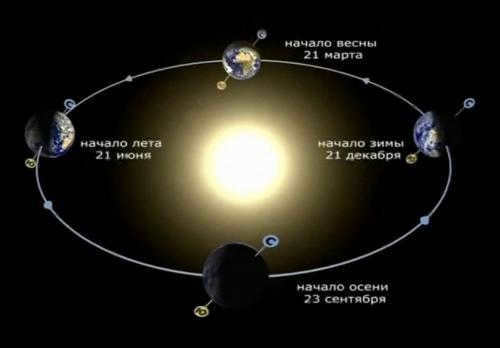
(The Earth’s Seasons in Transition)
Due to the tilt of the Earth’s axis in relation to its surface, different regions receive varying amounts of heat and light at different times, leading to the changing of seasons. Astronomical parameters are used to determine the timing of each season, with specific reference points being the Solstice Days (June 21 and December 22) for summer and winter, and the Equinoxes (March 20 and September 23) for spring and fall. From September to March, the Northern Hemisphere is tilted away from the Sun, resulting in less exposure to heat and light, thus bringing about winter. Conversely, during this time, the Southern Hemisphere experiences an abundance of heat and light, ushering in summer. After six months, as the Earth moves to the opposite point of its orbit, the Northern Hemisphere begins to receive more heat and light, resulting in longer days and a higher position of the Sun in the sky, signaling the arrival of summer.
If the Earth were positioned vertically in relation to the Sun, the seasons would not exist because all points on the sunlit side would receive the same amount of heat and light.
Why is the Earth round?
Have you ever wondered why the Earth is round? Why is it not flat, as it was once believed, or square? Why is it a sphere? And ultimately, what caused our planet to take on its spherical shape?
Firstly, a sphere is not an uncommon shape. In fact, it is one of the most common shapes in the universe. All stars, planets, moons, and large asteroids are round, or more specifically, spherical. This is due to one of the fundamental forces in the universe – gravity.

Gravity and its impact.
The force of gravity is a fascinating phenomenon. It plays a dominant role in the universe, governing the movement of planets, stars, and even entire galaxies. However, in the microscopic world, gravity has minimal influence and does not affect tiny objects such as atoms. This is because gravity’s strength is directly proportional to an object’s mass – the greater the mass, the stronger the force of attraction, and vice versa.
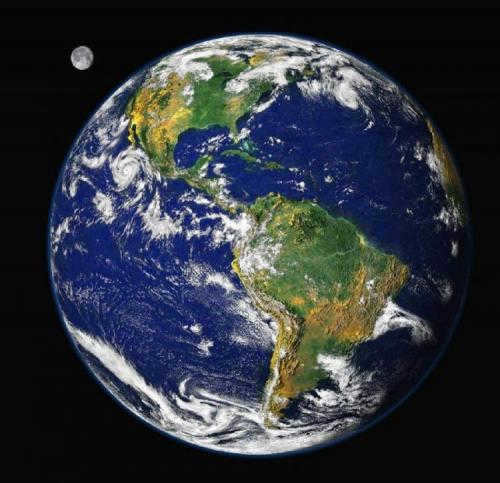
Due to the force of gravity, all large objects in the Universe take on a spherical shape. This is because the gravitational force is strong enough to pull in or push out different parts of the object until the entire surface is equidistant from the center. This gravitational force is always present and remains constant throughout the object’s existence. In other words, if for some unimaginable reason the Earth were to change its shape from a sphere to, let’s say, a cube, the force of gravity would eventually reshape it back into a sphere.
Why don’t all objects have a round shape?
If you’ve carefully read the previous two paragraphs, you would have learned that only objects with a very large mass and a corresponding force of gravity become round or spherical. However, there is another factor to consider. Astronomers have observed numerous large asteroids and dwarf planets that have sufficient mass but do not have a spherical shape. The explanation for this is quite simple: unlike stars and planets, asteroids are made entirely of rock and/or metal. Stars and planets, on the other hand, are mostly composed of liquid matter such as molten metals and gases, with only rare cases of planets being covered with a thin solid layer. As a result, gravity finds it much harder to change the shape of a solid object. However, over time, gravity will still strive to make the object round, although it will take much longer.
The Earth is not perfectly spherical.
It’s common knowledge that the Earth is not a perfect sphere! The Earth’s shape is more like an ellipse that is slightly flattened at the poles, which is known as a geoid in scientific terms. Additionally, certain areas of the Earth’s surface are either elevated or depressed compared to the overall level. This is due to the gravitational pull of the Moon, rather than the Earth itself. As the Moon orbits around our planet, it exerts a constant gravitational force on the Earth’s surface, resulting in ocean tides and even affecting land topography.
What is the Earth resting on?
A fresh perspective on our planet based on recent scientific discoveries and theories.
For centuries, science has asserted that the Earth is spherical. However, it may be time for humanity to reexamine the age-old notion that the Earth is flat. This idea holds a certain allure, shrouded in mystery due to its ancient origins.
But what does it mean for something to be flat? How can we define flatness? It refers to an object having only two dimensions, which is significantly smaller in scale compared to our three-dimensional world. To us, inhabitants of a three-dimensional reality, the two-dimensional realm, extensively explored by mathematicians, appears flat. However, it is conceivable that a one-dimensional world exists, where the concept of “flatness” would not apply to a two-dimensional plane.
Thus, we have successfully demonstrated the flatness of the Earth. Now, let us ascertain the identity of the three colossal entities that uphold its existence. It is no clandestine fact: in order to gain a comprehensive understanding of a phenomenon, one must sometimes possess not only the mind of a scientist, but also the soul of a poet.
“This is my firm stance!” individuals frequently proclaim when they wish to accentuate their correctness, their guiding principles. Could this not be the essence of the word “stands” in relation to the Earth? So, what serves as the foundation for our planet? Three whales (elephants) – it must be something of a global, immense, all-encompassing nature.
What are these three entities upon which humanity depends, to which it aspires? If we ponder deeply, we all recognize them from our earliest moments: Love, Goodness, and Beauty (Harmony). And in a more simplified and youthful rendition – Faith, Hope, Love.
And what about the turtle, which serves as the foundation for these whale-elephants? Considering the turtle has always symbolized slowness, it’s easy to infer that in this context it represents the Earth’s time moving slowly (from the perspective of beings from higher dimensions, of course).
Now we just need to figure out the “mistake” the ancients made in believing that the Earth is the center of the world. It’s best to abstract from the physical and shift to the conceptual level. Then everything falls into place. It becomes evident that the Earth is not in the spatial center, but rather the focal point of attention for a highly advanced cosmic civilization.
Therefore, the Earth occupies a central position in the world. It is not only flat, but also balanced on the backs of three majestic whales, which in turn rest upon the shell of a mighty turtle. This fascinating arrangement means that the focal point of the inhabitants of the multidimensional realm is the flat (albeit three-dimensional) Earth, where the journey towards love, goodness, and beauty is an incredibly arduous one.
Given this understanding, perhaps it would be wise for you and I to hasten this process? Why not commence our efforts right at this very moment!
Amidst attempts to “unearth the genuine shape of the Earth,” certain individuals propagate the same fallacy by showcasing an image of a “geoid,” which holds the same level of validity as the notion of a “flat Earth.” Allow me to clarify: the Earth is indeed a geoid, and the depiction of it is somewhat more intricate.

Changing Perspectives on the Shape of the Earth
Although this topic has been discussed extensively, it is important to acknowledge the outdated ideas that were prevalent in the past to have a comprehensive understanding of the subject. Therefore:

- In the first place, it is common knowledge that the Earth is a flat surface supported by three elephants standing on the shell of a massive celestial tortoise;
- The ancient Greeks also believed in a flat Earth, although they imagined it to be surrounded by an endless ocean (in defense of Greek scientists – at the beginning of Greek civilization, Plato and Aristotle, who are well-known to us, already considered the Earth to be spherical, and Eratosthenes was even able to approximately calculate its radius!);
- During the Renaissance, the belief in a spherical Earth became prevalent.
Contemporary scientific understanding of Earth’s form
Just as the general population was becoming accustomed to the concept of Earth being a sphere, Sir Isaac Newton proposed the idea that our planet’s shape was actually ellipsoidal. This theory was subsequently validated by numerous esteemed scientists.
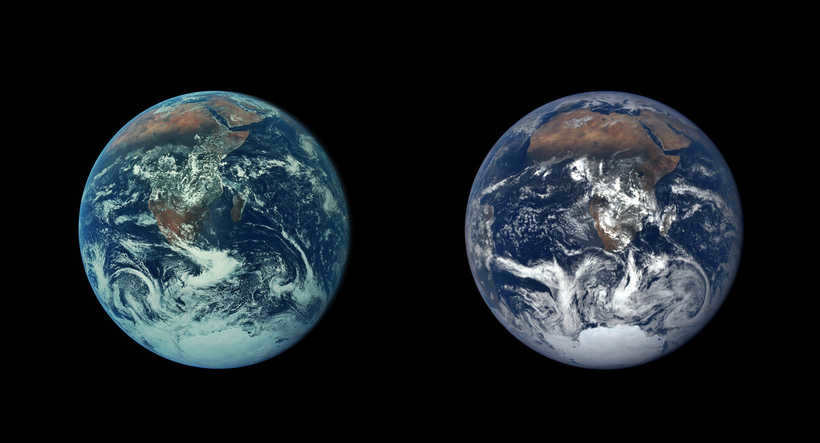
The shape of Planet Earth is slightly flattened at the poles due to its daily rotation. However, this spherical model is generally suitable for most problems that do not require extremely high accuracy.
Debunking Modern Myths and Falsities about Earth’s Shape
Earlier, I mentioned the modern myth surrounding the “true” model of Earth. While it is indeed the most contemporary model, it is actually a mathematical gravity model that represents Earth’s gravitational forces at various points, with blue areas indicating weaker gravity and red areas indicating stronger gravity. This model does not depict the “actual shape of Earth” nor does it portray the “shape of Earth without oceans”.
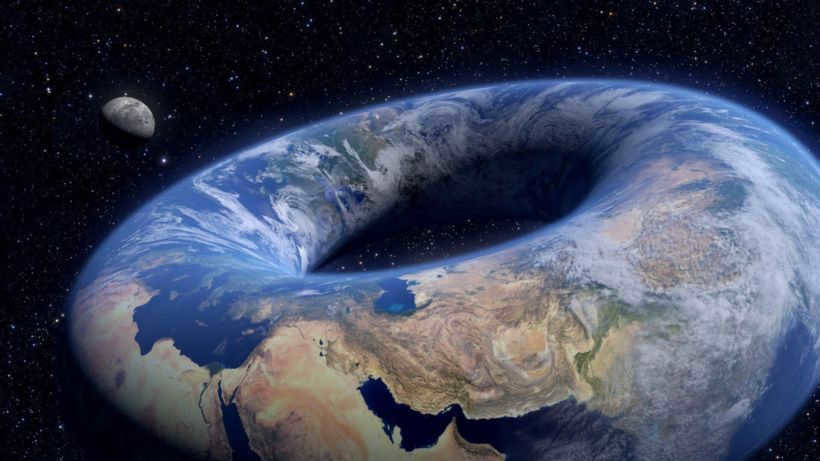
It is worth mentioning that there are still proponents of the notion of a “flat Earth”, actively providing evidence for their stance. A more unconventional concept is the hypothesis of a “concave Earth”.
Ever since I was young, I understood that all planets, including our own planet, Earth, had a spherical shape. I envisioned that when viewed from space, the Earth resembled a basketball with patches of seas, oceans, ice, and snow-capped mountain peaks. It amused me to imagine people walking upside down on the other side of the Earth, somewhere in America, akin to flies crawling on the ceiling. However, as I matured, my perspective on the Earth’s shape underwent a transformation due to reading books and attending geography lessons.

Development of Concepts about the Earth
Over the course of human history, there has been a gradual evolution in our understanding of the Earth and its characteristics. Some notable examples of this evolution include:

- there is a belief that the Earth is supported by elephants and a large tortoise.;
- there are ancient Greek maps depicting a flat Earthsurrounded on all sides by a single ocean;
- the writings of Aristotle and Newton provide evidence for the spherical nature of the Earth;
- the Catholic Church, for a long time, has denied the Earth being a sphere.
What is the Earth’s shape?
Contrary to common belief, the Earth does not have a spherical shape like a globe. The difference in size between the Earth’s equatorial and polar radii amounts to approximately 21 kilometers. Although this difference might seem insignificant given the planet’s overall size, it serves as a clear confirmation of this fact.
According to current scientific understanding, the Earth has a geoid shape. The term “geoid” comes from the Greek word meaning “something resembling the Earth,” which accurately describes our planet’s irregular shape that cannot be defined by any specific geometric figure. A geoid is an ellipsoidal shape that is slightly flattened at the poles, resulting in areas where the surface deviates from the normal.
Appearance of the geoid
The geoid can be likened to a plasticine ball, lacking perfect symmetry. Its surface is subject to distortion due to the gravitational pull exerted by celestial bodies in our solar system, namely, the Moon and the Sun.
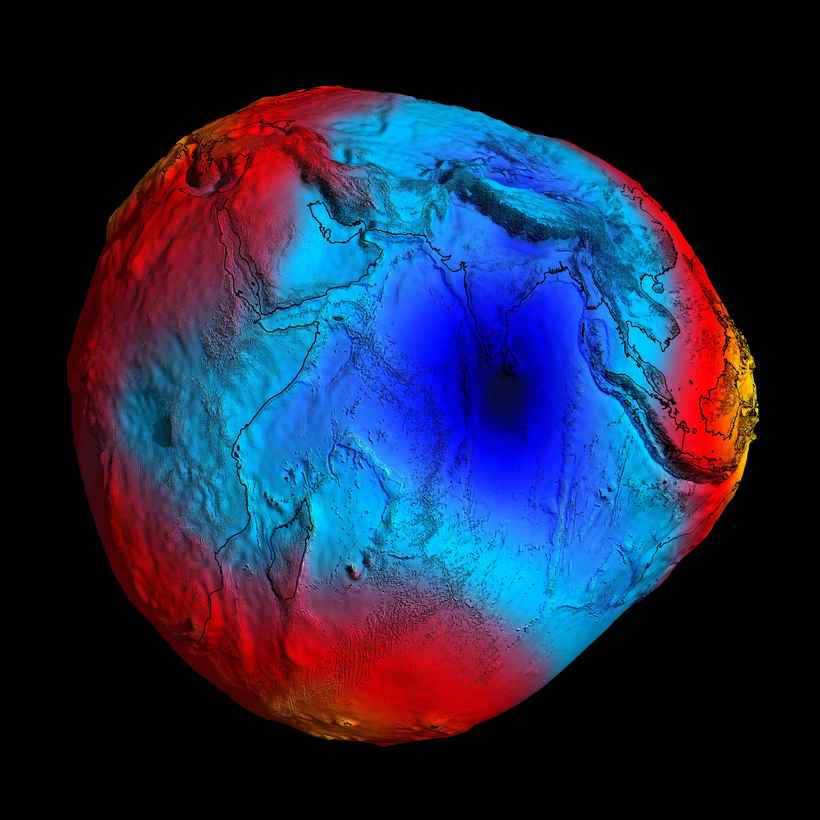
It should be emphasized that the theory of a flat Earth is still alive and well. Even in modern times, there exist individuals who refuse to accept the findings of scientific research and genuinely hold the belief that our planet is flat. However, that is a separate topic altogether.
It is common knowledge that the Earth is spherical in shape. This fact has been widely known and accepted since people first became curious about the world around them. Personally, I have always believed that the Earth is a perfect sphere, just like all other planets. However, one day after school, my daughter, as usual, started sharing all the interesting things she had learned. They were discussing the lithosphere in geography class, and the shape of our planet became a topic of heated debate. I argued that it was round, while my daughter claimed it was not round at all. To settle the argument, we decided to search for information on the Internet, and I was actually surprised. For the first time, my little girl was right. Now, I would like to share with you what I have discovered.

What is the form of the Earth?
Ever since humans gained the ability to explore space, countless possibilities for exploration have become available. Almost immediately, the question of the Earth’s shape was answered. Generally speaking, scientists tend to categorize and approximate the shape to a specific figure. To be completely precise, our Earth is actually an unpredictable form that cannot be fully described due to its constant changes.

The Earth’s Former Appearance as Perceived by Humans
People have historically envisioned the planet in the most peculiar and astonishing forms:

- The Greeks believed that the Earth was flat and encompassed by an ocean that was inaccessible. Every morning, Apollo, in his chariot, illuminated the sky, and the stars submerged in this ocean and were reborn at night.
- The Indians held the belief that the Earth was supported by four elephants, which stood on a colossal turtle that swam in a sea of milk and was coiled around an even larger snake.
- The Chinese perceived the Earth as a rectangular shape supported by pillars, with a circular sky above it. The dragon bent one of the pillars, resulting in the sun consistently setting in the west and rising in the east.
- The ancient Slavs believed that a massive tree connected all seven worlds, and at the top of this tree was the island of Buyan, where the ancestors of all animals resided.
- In the Egyptian belief system, the Earth was structured with the goddess of soil at the bottom, the sky at the top, and the sun god traversing it from dawn to dusk.
- The ancient Mayans perceived the Earth as a square, with the sky supported by five trees: red in the east, white in the north, black in the west, yellow in the south, and a green tree in the center. The colors of these trees represented the different times of the day.
Throughout my education, I had always felt confident in my ability to answer any question posed to me. However, when I was recently asked a basic question about the Earth’s shape, I confidently responded that it was a sphere. To my surprise, I was mistaken. While not a catastrophic error, it was still a significant oversight on my part.

So, what is the true form of our planet?
In order to comprehend this, we must carry out a couple of straightforward tasks:

- Get a rubber ball.
- Imagine drawing a diagonal line that divides the ball in half, similar to how the Earth is divided along its axis.
- Mark two dots on the surface of the ball where the imaginary line intersects, representing the poles.
- Apply a slight pressure at these two points on the ball.
You receive a spherical object, albeit slightly compressed. Researchers would refer to it as a geoid. This assumes that we are not taking into account the planet’s topography, but rather making an approximation. We are simplifying it because when considering the Earth’s magnitude, even the elevation of mountains can be disregarded.
Perhaps it is actually a flat Earth
Recently, a viral video circulated on the internet featuring a young schoolboy espousing a controversial belief – that the Earth is flat and scientists are clueless. While it may be tempting to dismiss this as a baseless conspiracy theory, there are actually numerous pieces of evidence that are difficult to refute.
It is widely known that during daytime, one part of the planet experiences daylight while another is in darkness. Additionally, the seasons vary at different ends of the Earth. If the Earth were truly shaped like a flat disk, how would these phenomena be explained?

Indeed, when observing the curvature of the Earth’s surface. one can notice that it has a curved shape. If the Earth were flat, the horizon would appear as a straight line. Although there are other phenomena that could explain this observation, they are inconsistent with the presence of gravity. The presence of gravity has already been verified by physicists and validated through independent experiments.

Moreover, if the Earth was actually flat, it would be feasible for you to ascend a tall tree and utilize a pair of high-powered binoculars to observe every town or village. However, attempt to ascend a tower and catch sight of Australia!
Lastly, and most importantly. Images captured from space. Absolutely, you can argue endlessly that they are fabricated and manipulated, but certain photographs exhibit no signs of editing.

Game over, flat-earthers!
I have only witnessed an impeccable balloon. And it would be great to conclude the statement about unedited photos that depict the true shape of our planet with references to these images.
I am fond of inquiries that are more intricate than they appear initially. A seemingly straightforward query can conceal an entire essay or even a scientific research. Therefore, when it comes to the shape of the Earth, while it suffices to explain to a young child that it is round and not flat, adults seek to delve into the specifics.
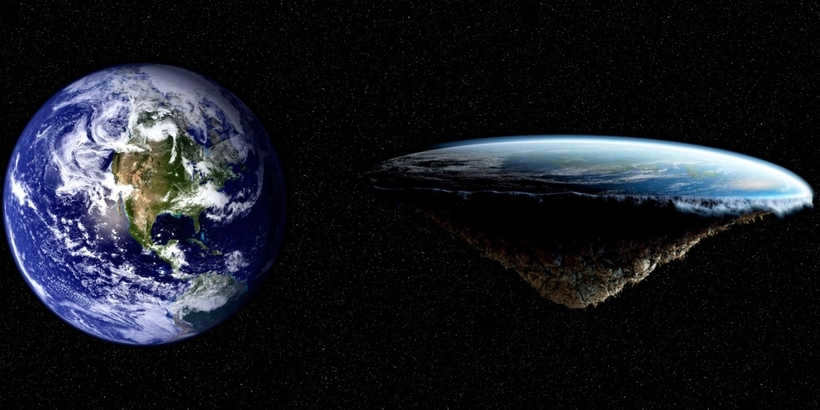
What is the shape of the Earth?
During my time in higher education, I was fortunate to have exceptional educators who prioritized understanding over the memorization of isolated facts. One of my professors once enlightened me on the concept that there are numerous answers to any given question, ranging from highly precise yet impractical to practically applicable yet less accurate.
Take, for instance, the question of the Earth’s shape. The most precise response can be found in topographic maps, which depict the unevenness of our planet’s surface, including its mountains and valleys. This representation reflects the true shape of the Earth. Thanks to modern satellites, we can now measure the distance from any location on the Earth’s surface to its center with an error margin of just 2 cm.
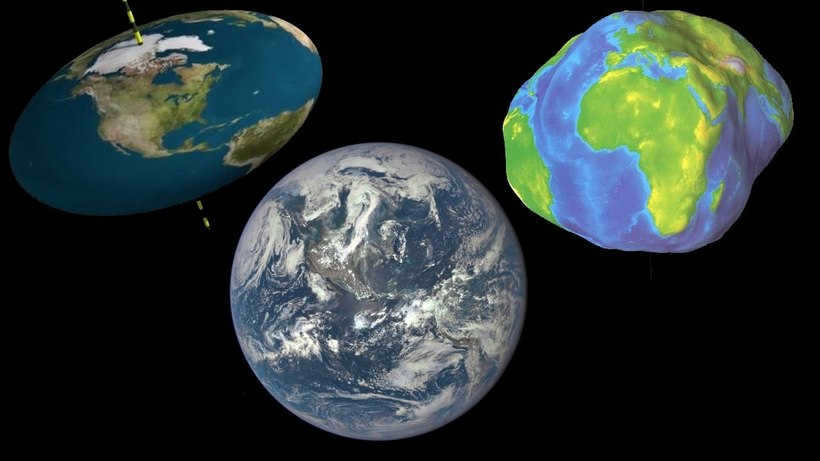
One possible answer that is applicable in various situations is that the Earth has a flat shape. When navigating through a city or trying to avoid getting lost in a forest, this simple representation is sufficient. In ancient times, people relied on this understanding for all aspects of life. However, for long-distance travel, it is more practical to consider our planet as a spherical object, like a ball.
Many times, the person asking the question desires a different answer. Typically, they are inquiring about a preferred reference point for measuring height and depth. This reference point would be a surface that allows us to avoid going uphill or downhill, or exerting additional effort against gravity. Liquids naturally take on this shape. Scientists refer to this surface as the geoid, and at every location, it is perpendicular to the direction of the plumb line.
What does a geoid look like? The shape and direction of the plumb line are influenced by centrifugal and gravitational forces. It is the Earth’s rotation that gives it its unique shape – not just a perfect sphere, but a flattened one. This is because the radius of the planet is 21 kilometers greater at the equator than at the pole. This difference is much more significant on a planetary scale than the tallest mountains or deepest trenches.
The geoid surface may seem very smooth, but it actually considers even the tiniest variations in the topography. It takes into account small irregularities such as voids beneath the Earth’s surface, which can cause a slight decrease in the geoid level. Similarly, heavy rock deposits can cause the geoid level to be slightly higher. In areas with deep ocean trenches, the geoid is flattened due to the lower density of water compared to solid rocks.
Working with such a complex surface is impractical, so people use various approximations to simplify the process.
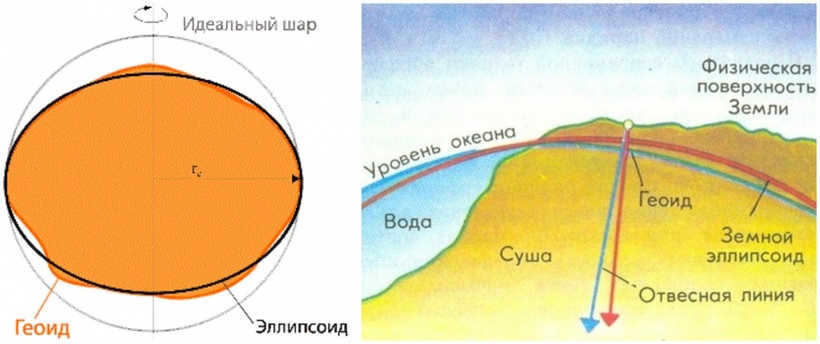
- The Earth is a sphere with a radius of approximately 6,371 kilometers.
- An ellipsoid is a rotating body, resembling a flattened ball. It has a radius of about 6357 km at the poles and 6378 km at the equator.
- Sea level refers to the average level of water in the oceans, extending smoothly beneath the continents. Local gravitational anomalies are not taken into account. This is the reference point for measuring elevations and depths in geography.
- A quasigeoid is a complex structure that deviates from the geoid in shape by no more than 2 meters in mountainous regions and a few centimeters on flat terrains. It represents a highly accurate estimation of the geoid across the entire surface of the Earth.
Moreover, the Earth’s shape is not constant and can undergo changes over time due to various factors, including the shifting of continents and other geological processes. On the other hand, the water surrounding the Earth is subject to daily fluctuations caused by winds, ocean currents, and the gravitational pull of the moon.
Gone are the days when people held the naive belief that the Earth was a flat, disk-shaped object. Nowadays, even young children are aware that our planet is a spherical body that orbits the Sun. It is common knowledge that the Earth is vast in size, and traveling between certain countries can require a flight lasting up to 24 hours.
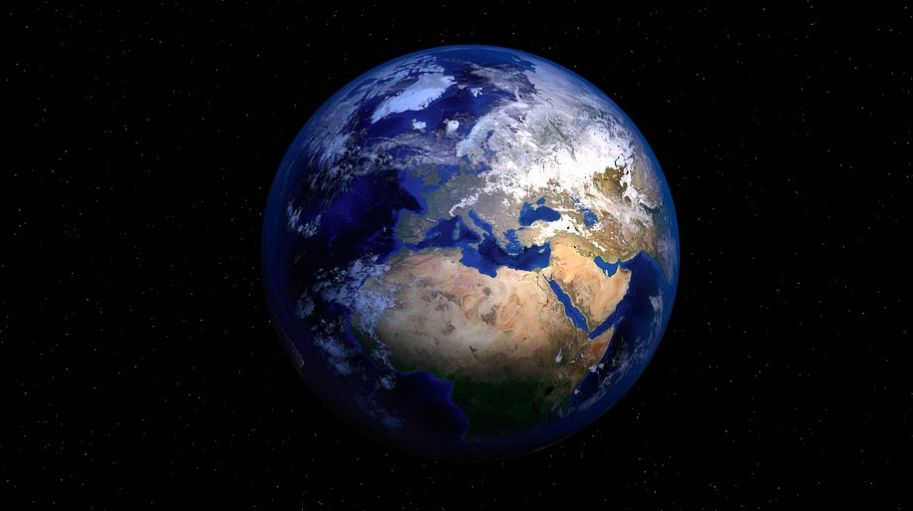
However, only a few individuals possess the precise knowledge of Earth’s radius, equatorial length, surface area, or weight. Furthermore, a significant number of individuals are oblivious to the fact that, contrary to common belief, our planet has a shape that more closely resembles an ellipsoid than a perfect sphere. Today, we aim to enlighten you not only about the dimensions of the Earth but also about its unique shape.
Historical context
It took a considerable amount of time for humans to discover the spherical shape of our planet. In ancient times, our ancestors believed that the Earth was a flat disk supported by turtles and elephants. This belief stemmed from the fact that the planet’s immense size made its curvature imperceptible to the naked eye, creating the illusion of a relatively flat surface. Only from great heights could a slight shift in the horizon line be observed.
Consequently, many people in ancient times never considered the possibility that the Earth could be a sphere and genuinely believed that there was an endpoint to it. Throughout the centuries, adventurous explorers attempted to reach the edge of the Earth in hopes of discovering what lay beyond… However, as history shows, none of them were successful.
In ancient Greece, around the 7th century BC, people started contemplating the idea that the Earth had a spherical shape. One of the proponents of this seemingly incredible theory was Aristotle. The renowned scientist spent numerous years gathering evidence in an effort to convince his contemporaries of the accuracy of this assumption.
Aristotle supported his theory with a variety of arguments. He not only relied on the accounts of various travelers, but also pointed out that the appearance of the starry sky above changed constantly, and during lunar eclipses, the Earth cast a round shadow instead of a flat one. Additionally, as time went on, more and more travelers began to believe in the validity of this theory. They would depart from one point on the planet and return without ever encountering the mythical edge of the Earth.
After many centuries, scientists have confirmed Aristotle’s correctness and the accuracy of his other scientific colleagues.
Today, the round shape of the Earth is an undeniable scientific truth, as well as the fact that it is constantly orbiting the sun alongside Venus and Mars at an average speed of just under 30 km/sec.
It may come as a surprise to many that the Earth actually completes a full rotation on its axis not in a day, as commonly believed, but in 23 hours, 56 minutes, and 4.1 seconds.
The understanding of the Earth’s shape and size did not come about immediately, but through extensive research. What is particularly fascinating is that, contrary to popular belief, the planet does not have a perfectly spherical shape, but rather resembles an ellipse. It is now known that the Earth has a large volumetric oval shape that is slightly flattened at the poles and elongated in the equatorial zone.
In 1873, a conventional term was introduced to describe this shape, known as the “Geoid” (meaning earth-like), which is still in use today. The geoid of a planet is a complex geometric surface that closely resembles an ellipsoid, although it is not a perfectly flat figure. It is simply the closest approximation to an ellipsoid with a compression ratio of 1:298.2.
The Earth spins around its axis in a manner that keeps its poles nearly stationary. The equator, a line encircling the Earth at an equal distance from the poles, is considered the center of the Earth. The lines that run parallel to the equator on different maps are known as parallels, while the lines that connect the poles are called meridians.
These lines are used by experts to determine the geographic coordinates of a specific location, including its latitude (measured by parallels) and longitude (measured by meridians).
Latitude indicates the distance from a point to the equator and ranges from 90 degrees north to 90 degrees south. Longitude, on the other hand, can be either west or east and is measured from 0 to 180 degrees.
The Dimensions of Planet Earth
Throughout history, scientists have diligently sought answers to the questions that once puzzled our ancient ancestors. They not only confirmed the Earth’s spherical shape but also successfully measured its size.
Through extensive research, it has been determined that the Earth’s radii have varying lengths:
- The mean radius of the planet is approximately 6,371 kilometers;
- The polar radius measures around 6,356 kilometers;
- The equatorial radius spans approximately 6,378 kilometers.
As previously mentioned, the Earth takes on an elliptical shape, with the widest circumference near the equator, measuring over 40,000 kilometers in length.
Clearly, our planet is of enormous proportions. Its total surface area is an astounding 510.2 million square kilometers, and its mass reaches a staggering 5.976 x 10^24 kilograms.
Furthermore, the average density of the Earth is known to be 5,518 kilograms per cubic meter.





